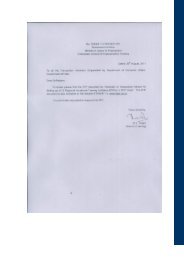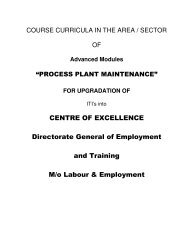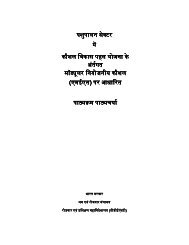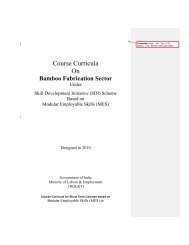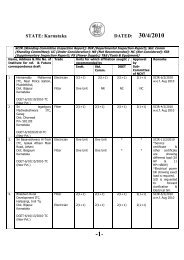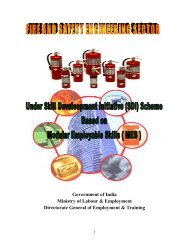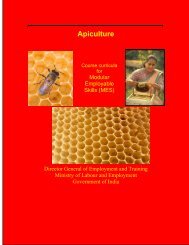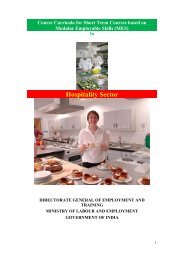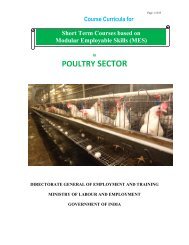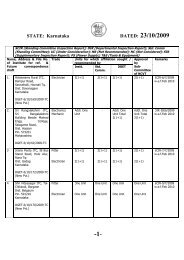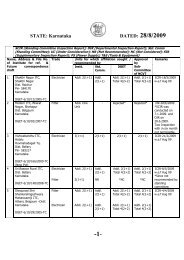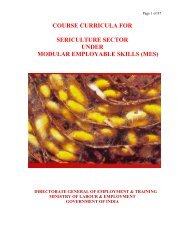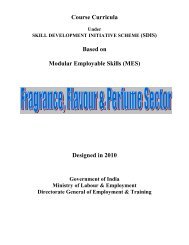Garments Sector - Directorate General of Employment & Training
Garments Sector - Directorate General of Employment & Training
Garments Sector - Directorate General of Employment & Training
Create successful ePaper yourself
Turn your PDF publications into a flip-book with our unique Google optimized e-Paper software.
Course Curriiculla<br />
for<br />
Short Term Courses based on<br />
Modullar Emplloyablle Skiilllls (MES)<br />
iin<br />
<strong>Garments</strong> <strong>Sector</strong><br />
DIRECTORATE GENERAL OF EMPLOYMENT AND TRAINING<br />
MINISTRY OF LABOUR & EMPLOYMENT<br />
GOVERNMENT OF INDIA
Course Curricula for Short Term Courses based on Modular<br />
Employable Skills (MES) in the <strong>Garments</strong> <strong>Sector</strong><br />
CONTENTS<br />
1. Background ..................................................................................................................... 2<br />
2. Frame Work for Skill Development based on Modular Employable Skills ..................... 2<br />
3. Age <strong>of</strong> Participants .......................................................................................................... 3<br />
4. Curriculum Development Process ................................................................................... 3<br />
5. Development <strong>of</strong> Core Competencies ............................................................................... 3<br />
6. Duration <strong>of</strong> the Programmes ........................................................................................... 4<br />
7. Pathways to acquire Qualification ................................................................................... 4<br />
8. Methodology .................................................................................................................... 5<br />
9. Instructional Media Packages .......................................................................................... 5<br />
10. Assessment ..................................................................................................................... 5<br />
11. Certificate ........................................................................................................................ 5<br />
12. Course Matrix .................................................................................................................. 6<br />
13. Module ............................................................................................................................. 7<br />
14. Hand Embroider .............................................................................................................. 7<br />
15. Machine Embroidery Operator ........................................................................................ 8<br />
16. Garment packer ............................................................................................................... 9<br />
17. Garment Ironer .............................................................................................................. 10<br />
18. Maintenance <strong>of</strong> Machines in Garment <strong>Sector</strong>s .............................................................. 11<br />
19. Basic Sewing Operator .................................................................................................. 12<br />
20. Computerized Embroidery Machine Operator ............................................................... 14<br />
21. Garment Cutter .............................................................................................................. 15<br />
22. Garment Checkers ........................................................................................................ 16<br />
23. Skilled Sewing Operators .............................................................................................. 17<br />
24. Special Sewing Machine Operator ................................................................................ 18<br />
25. Tailor Children .............................................................................................................. 19<br />
26. Tailor Ladies ................................................................................................................. 21<br />
27. Tailor Gent’s .................................................................................................................. 23<br />
28. Tailor Suits ..................................................................................................................... 25<br />
29. List <strong>of</strong> Expert/Trade Committee Members ..................................................................... 27<br />
1
Skill Development based on Modular Employable Skills (MES)<br />
Background<br />
The need for giving emphasis on the Skill Development, especially for the less<br />
educated, poor and out <strong>of</strong> school youth has been highlighted in various forums. The skill<br />
level and educational attainment <strong>of</strong> the work force determines the productivity, income levels<br />
as well as the adaptability <strong>of</strong> the working class in changing environment. Large percentage<br />
<strong>of</strong> population in India is living below poverty line. One <strong>of</strong> the important causes is lower<br />
percentage <strong>of</strong> skilled persons in the workforce<br />
The skill development at present is taking place mostly in the informal way, i.e.<br />
persons acquire skill at the work-place when they help their parents, relatives and employers<br />
etc. Such persons do not have a formal certificate and thus earn lower wages and are<br />
exploited by employers. They have come through informal system due to socio-economic<br />
circumstances <strong>of</strong> the family and the compulsions <strong>of</strong> earning a livelihood rather than<br />
attending a formal course. While their productivity is low, their contribution to the national<br />
GDP cannot be ignored. If the country can create a system <strong>of</strong> certification which not only<br />
recognizes their skills but also provides education and training in a mode that suits their<br />
economic compulsions, it will not only benefit the workforce to earn a decent living but also<br />
contribute to the national economy by better productivity <strong>of</strong> this workforce.<br />
Another related problem to be tackled is large number <strong>of</strong> students drop outs (About<br />
63% <strong>of</strong> the school students drop out at different stages before reaching Class-X).<br />
Frame work for Skill Development based on ‘Modular Employable Skills (MES)’<br />
Very few opportunities for skill development are available for the above referred<br />
groups (out <strong>of</strong> school youth & existing workers especially in the informal sector). Most <strong>of</strong> the<br />
existing Skill Development programmes are long term in nature. Poor and less educated<br />
persons can not afford long term training programmes due to higher entry qualifications,<br />
opportunity cost etc. Therefore, a new frame work for Skill Development for the Informal<br />
<strong>Sector</strong> has been evolved by the DGET to address to the above mentioned problems. The<br />
key features <strong>of</strong> the new frame work for skill development are:<br />
Demand driven Short term training courses based on modular employable skills<br />
decided in consultation with Industry<br />
Flexible delivery mechanism (part time, weekends, full time)<br />
Different levels <strong>of</strong> programmes (Foundation level as well as skill upgradation) to meet<br />
demands <strong>of</strong> various target groups<br />
Central Government will facilitate and promote training while Vocational <strong>Training</strong> (VT)<br />
Providers under the Govt. and Private <strong>Sector</strong> will provide training<br />
Optimum utilisation <strong>of</strong> existing infrastructure to make training cost effective.<br />
Testing <strong>of</strong> skills <strong>of</strong> trainees by independent assessing bodies who would not be<br />
involved in conduct <strong>of</strong> the training programme, to ensure that it is done impartially.<br />
Testing & certification <strong>of</strong> prior learning (skills <strong>of</strong> persons acquired informally)<br />
2
The Short Term courses would be based on ‘Modular Employable Skills (MES)’.<br />
The concept for the MES is :<br />
<br />
<br />
<br />
<br />
Identification <strong>of</strong> ‘minimum skills set’ which is sufficient to get an employment in the labour<br />
market.<br />
It allows skills upgradation, multiskilling, multi entry and exit, vertical mobility and life long<br />
learning opportunities in a flexible manner.<br />
It also allows recognition <strong>of</strong> prior learning (certification <strong>of</strong> skills acquired informally)<br />
effectively.<br />
The modules in a sector when grouped together could lead to a qualification equivalent<br />
to National Trade Certificate or higher.<br />
Courses could be available from level 1 to level 3 in different vocations depending upon<br />
the need <strong>of</strong> the employer organisations.<br />
MES would benefit different target groups like :<br />
o Workers seeking certification <strong>of</strong> their skills acquired informally<br />
o workers seeking skill upgradation<br />
o early school drop-outs and unemployed<br />
o previously child labour and their familly<br />
Age <strong>of</strong> participants<br />
The minimum age limit for persons to take part in the scheme is 14 years but there is<br />
no upper age limit.<br />
Curriculum Development Process<br />
Following procedure is used for developing course curricula<br />
• Identification <strong>of</strong> Employable Skills set in a sector based on division <strong>of</strong> work in the labour<br />
market.<br />
• Development <strong>of</strong> training modules corresponding to skills set identified so as to provide<br />
training for specific & fit for purpose<br />
• Organization <strong>of</strong> modules in to a Course Matrix indicating vertical and horizontal mobility.<br />
The course matrix depicts pictorially relation among various modules, pre requisites for<br />
higher level modules and how one can progress from one level to another.<br />
• Development <strong>of</strong> detailed curriculum and vetting by a trade committee and by the NCVT<br />
(Close involvement <strong>of</strong> Employers Organizations, State Governments, experts, vocational<br />
training providers and other stake holders is ensured at each stages).<br />
Development <strong>of</strong> Core Competencies<br />
Possession <strong>of</strong> proper attitudes is one <strong>of</strong> the most important attribute <strong>of</strong> a competent person.<br />
Without proper attitudes, the performance <strong>of</strong> a person gets adversely affected. Hence,<br />
systematic efforts will be made to develop attitudes during the training programme.<br />
The trainees deal with men, materials and machines. They handle sophisticated tools and<br />
instruments. Positive attitudes have to be developed in the trainees by properly guiding<br />
3
them and setting up examples <strong>of</strong> good attitudes by demonstrated behaviors and by the<br />
environment provided during training.<br />
Some important core competencies to be developed are:<br />
1. Safety consciousness and safe working practices<br />
2. Care <strong>of</strong> equipment and tools<br />
3. Punctuality, discipline and honesty<br />
4. Concern for quality<br />
5. Respect for rules and regulations<br />
6. Concern for health and hygiene<br />
7. Cordial relationship and Cooperation with co-workers and team Work<br />
8. Positive attitude and behavior<br />
9. Responsibility and accountability<br />
10. Learn continously<br />
11. Communication Skills<br />
12. Concern for environment and waste disposal<br />
Following competencies should also be developed during level-II and higher courses:<br />
1. Ability for planning, organizing and coordinating<br />
2. Creative thinking, problem solving and decision making<br />
3. Leadership<br />
4. Ability to bear stress<br />
5. Negotiation<br />
Duration <strong>of</strong> the Programmes<br />
Time taken to gain the qualification will vary according to the pathway taken and will be kept<br />
very flexible for persons with different backgrounds and experience. Duration has been<br />
prescribed in hours in the curriculum <strong>of</strong> individual module, which are based on the content<br />
and requirements <strong>of</strong> a MES Module. However, some persons may take more time than the<br />
prescribed time. They should be provided reasonable time to complete the course.<br />
Pathways to acquire Qualification:<br />
Access to the qualification could be through:<br />
• An approved training programme; Or<br />
• A combination <strong>of</strong> an approved training programme plus recognition <strong>of</strong> prior<br />
learning including credit transfer; Or<br />
• The recognition <strong>of</strong> prior learning that provides evidence <strong>of</strong> the achievement <strong>of</strong><br />
the competencies for the qualification.<br />
4
Methodology<br />
The training methods to be used should be appropriate to the development <strong>of</strong> competencies.<br />
The focus <strong>of</strong> the programme is on “performing” and not on “Knowing”. Lecturing will be<br />
restricted to the minimum necessary and emphasis to be given for ‘hands on training’.<br />
The training methods will be individual centered to make each person a competent one.<br />
Opportunities for individual work will be provided. The learning process will be continuously<br />
monitored and feedback will be provided on individual basis.<br />
Demonstrations using different models, audio visual aids and equipment will be used<br />
intensively.<br />
Instructional Media Packages<br />
In order to maintain quality <strong>of</strong> training uniformly all over the country, instructional media<br />
packages (IMPs) will be developed by the National Instructional Media Institute (NIMI),<br />
Chennai.<br />
Assessment<br />
DGE&T will appoint assessing bodies to assess the competencies <strong>of</strong> the trained persons.<br />
The assessing body will be an independent agency, which will not be involved in conducting<br />
the training programmes. This, in turn, will ensure quality <strong>of</strong> training and credibility <strong>of</strong> the<br />
scheme. Keeping in view the target <strong>of</strong> providing training/testing <strong>of</strong> one million persons<br />
through out the country and to avoid monopoly, more than one assessing bodies will be<br />
appointed for a sector or an area.<br />
Certificate<br />
Successful persons will be awarded certificates issued by National Council for Vocational<br />
<strong>Training</strong> (NCVT).<br />
5
Course Matrix<br />
COURSE MATRIX based on MODULAR EMPLOYABLE<br />
SKILLS (MES) for the GARMENT SECTOR<br />
Certificate-II<br />
Computerized<br />
Embroidery<br />
machine<br />
Operator<br />
Garment<br />
Cutter<br />
Garment<br />
Checker<br />
Skilled<br />
Sewing<br />
Operator<br />
Special<br />
Sewing<br />
Machine<br />
Operator<br />
Tailor<br />
Children’s<br />
Tailor<br />
Ladies<br />
Tailor<br />
Gents<br />
Tailor<br />
Suits<br />
Certificate-I<br />
Hand<br />
Embroider<br />
Machine<br />
Embroidery<br />
Operator<br />
Garment<br />
Packer<br />
Garment<br />
Ironer<br />
Maintenan<br />
ce <strong>of</strong><br />
Machines<br />
in<br />
Garment<br />
<strong>Sector</strong><br />
Tailor<br />
Basic Sewing operator
Modules<br />
Modules MODULE – I (Certificate Level – I)<br />
Hand Embroider<br />
NAME<br />
SECTOR<br />
Hand Embroider<br />
<strong>Garments</strong><br />
CODE<br />
ENTRY QUALIFICATION:<br />
Minimum 5 th Std. , 14 years <strong>of</strong> Age.<br />
TERMINAL COMPETENCY: After completion <strong>of</strong> the course the trained person would be able<br />
to make decorative handicrafts, do embroidery at necklines,<br />
yokes, sleeves, kameez etc.<br />
DURATION<br />
CONTENT<br />
: 210 Hrs.<br />
:Using stitches as a decorative feature & to take up any type <strong>of</strong><br />
embroidery work.<br />
Practical Competencies<br />
‣ Practice Health & Safety – select, use,<br />
maintain & store – tools, equipments &<br />
clothing safely<br />
‣ Practice <strong>of</strong> basic stitches<br />
‣ Application <strong>of</strong> decorative stitches<br />
‣ To design & practice motifs, floral<br />
designs, geometrical design and to<br />
finish with various decorative stitches<br />
‣ Practice on different types <strong>of</strong><br />
embroidery works like zardozi, ribbon,<br />
beads, mirror work etc.<br />
Underpinning Knowledge<br />
(Theory)<br />
‣ Importance <strong>of</strong> hand<br />
embroidery<br />
‣ Uses <strong>of</strong> different Basic<br />
& Decorative stitches<br />
‣ Method <strong>of</strong> Transferring<br />
a Design.<br />
‣ Safety precaution to<br />
be taken while using<br />
embroidery tools.<br />
TOOLS AND EQUIPMENTS FOR A BATCH OF 20 TRAINEES.<br />
S.NO. DESCRIPTION<br />
QUANTITY<br />
1. Embroidery Needle 20 Nos.<br />
2 Tracing Paper 20 Nos.<br />
3 Embroidery Frame 20 Nos.<br />
4 Big & Small trimming scissors 20 Nos.<br />
5 Trimmers 20 Nos.
MODULE – II (Certificate Level – I)<br />
Machine Embroidery Operator<br />
NAME<br />
SECTOR<br />
Machine Embroidery Operator<br />
<strong>Garments</strong><br />
CODE<br />
ENTRY QUALIFICATION: Minimum 5 th Std., 14 years <strong>of</strong> Age<br />
TERMINAL COMPETENCY: The candidate would be able to perform Machine Embroidery on<br />
Fabrics & garments for children, women & Men.<br />
DURATION:<br />
CONTENT<br />
210 Hrs.<br />
Using stitches as a decorative feature and to do machine embroidery in various<br />
garments & household articles apply them in various garments and articles<br />
Practical Competencies<br />
‣ Practice Health & Safety – select, use,<br />
maintain & store – tools, equipments &<br />
clothing safely<br />
‣ Practice <strong>of</strong> machine embroidery on<br />
machine. Control <strong>of</strong> the machine &<br />
movement balance To apply different<br />
decorative stitches with the help <strong>of</strong> a<br />
special embroidery sewing machine<br />
‣ To sew various designs like Motifs,<br />
Logo, Monogram, Appliqués, Animal<br />
designs<br />
‣ Lockstitch & chain stitch, and all kind<br />
<strong>of</strong> embroidery practice & application.<br />
Underpinning Knowledge<br />
(Theory)<br />
‣ Knowledge <strong>of</strong> different<br />
needles & threads and its<br />
uses.<br />
‣ Knowledge <strong>of</strong> Embroidery<br />
Sewing Machine, stitches &<br />
color combination<br />
‣ Method <strong>of</strong> transferring a<br />
design<br />
‣ Cautions to be taken while<br />
working on an embroider<br />
Machine.<br />
TOOLS AND EQUIPMENTS FOR A BATCH OF 20 TRAINEES.<br />
S.NO. DESCRIPTION<br />
QUANTITY<br />
1. Embroidery Machine Needle 20 Nos.<br />
2 Power Embroidery Machine 20 Nos.<br />
3 Embroidery Frame 20 Nos.<br />
4 Big & Small trimming scissors 20 Nos.<br />
5 Trimmers 20 Nos.<br />
8
MODULE - III (Certificate Level – I)<br />
Garment Packer<br />
NAME<br />
SECTOR<br />
Garment Packer<br />
<strong>Garments</strong><br />
CODE<br />
ENTRY QULIFFICATION Minimum 5 th Std., 14 years <strong>of</strong> Age<br />
TERMINAL COMPETENCY: The candidates would be able to pack finished garments in any Garment Industry.<br />
DURATION:<br />
CONTENT :<br />
packing.<br />
120 Hrs.<br />
Packing <strong>of</strong> garments,colour wise, size, trademark and different types <strong>of</strong><br />
Practical Competencies<br />
‣ Practice Health & Safety – select, use,<br />
maintain & store – tools, equipments &<br />
clothing safely<br />
‣ To practice folding <strong>of</strong> garments<br />
‣ To practice packing color wise, tags,<br />
and trademarks, labels, to pack in poly<br />
bags, cardboard cartoons.<br />
‣ Practice on needle detector machine.<br />
‣ Quality control<br />
Underpinning Knowledge<br />
(Theory)<br />
‣ Knowledge <strong>of</strong> Color,<br />
Texture, Fabric<br />
‣ Knowledge <strong>of</strong> various<br />
accessories.<br />
‣ Packing procedure.<br />
Knowledge <strong>of</strong> quality<br />
aspects, loose threads,<br />
broken buttons, fabric<br />
defects etc.<br />
‣ Knowledge <strong>of</strong> packing ratio<br />
as per specification sheet,<br />
knowledge <strong>of</strong> ironing<br />
&needle detector.<br />
‣ Safety precautions<br />
TOOLS AND EQUIPMENTS FOR A BATCH OF 20 TRAINEES.<br />
S.NO. DESCRIPTION<br />
QUANTITY<br />
1. Tables 5 Nos.<br />
2 Small Scissors 5 Nos.<br />
3 Trimmers 5 Nos.<br />
4 Seam Rippers 5 Nos.<br />
5 Fabric checking machine 1 Nos.<br />
9
MODULE – IV (Certificate Level – I)<br />
Garment Ironer<br />
NAME<br />
SECTOR<br />
Garment Ironer<br />
<strong>Garments</strong><br />
CODE<br />
ENTRY QUALIFICATION:<br />
Minimum 5 th Std., 14 years <strong>of</strong> Age<br />
TERMINAL COMPETENCY: The Candidate would be able to Iron various garments in any<br />
Garment Industry using different types <strong>of</strong> iron. He/ she would also be able to remove stains,<br />
spots and give a good finish look to the garment.<br />
DURATION:<br />
CONTENT:<br />
garments .<br />
120 Hrs.<br />
Ironing techniques using steam iron dummy blowers and to press various<br />
Practical Competencies<br />
‣ Practice Health & Safety – select, use,<br />
maintain & store – tools, equipments &<br />
clothing safely<br />
‣<br />
‣ Practice <strong>of</strong> Ironing the garments as per<br />
fold to the specified size.<br />
‣<br />
‣ Practice <strong>of</strong> ironing in steam pressing,<br />
dummy blowers.<br />
Underpinning Knowledge<br />
(Theory)<br />
‣ Safety precautions<br />
while handling various<br />
types <strong>of</strong> irons.<br />
‣ Knowledge <strong>of</strong> threads<br />
sucking machine, spot<br />
cleaning machine &<br />
quality aspect.<br />
‣<br />
TOOLS AND EQUIPMENTS FOR A BATCH OF 20 TRAINEES.<br />
S.NO. DESCRIPTION<br />
QUANTITY<br />
1. Pressing table 5 Nos.<br />
2 Automatic Iron 5 Nos.<br />
3 Steam Iron 5 Nos.<br />
4 Vacuum table 5 Nos.<br />
5 Metal detector machine 1 Nos.<br />
6 Sleeve board 1 Nos.<br />
10
MODULE – V (Certificate Level – I)<br />
Maintenance <strong>of</strong> Machines in <strong>Garments</strong> <strong>Sector</strong>.<br />
NAME<br />
SECTOR<br />
Maintenance <strong>of</strong> Machines in <strong>Garments</strong> <strong>Sector</strong>.<br />
Garment<br />
CODE<br />
ENTRY QUALIFICATION<br />
8 TH STANDARD 14 years AND ABOVE<br />
TERMINAL COMPETENCY: The candidate would be able to repair & maintain various<br />
machinery for Garment making, trouble shooting and to fix and change special attachments.<br />
DURATION:<br />
300 Hrs<br />
CONTENT :<br />
Practical Competencies<br />
‣ Practice Health & Safety – select,<br />
use, maintain & store – tools,<br />
equipments & clothing safely<br />
‣<br />
‣ Machine control<br />
‣ Installation on single needle,<br />
double needle, over lock, highspeed<br />
sewing machines, cutting<br />
machine, fusing machine &<br />
finishing machinery.<br />
‣ Installation <strong>of</strong> Special machine.<br />
‣ Practice <strong>of</strong> stitches per inches,<br />
changing <strong>of</strong> needles, changing <strong>of</strong><br />
special attachments & fixing.<br />
Underpinning Knowledge<br />
(Theory)<br />
‣ Introduction <strong>of</strong> machinery<br />
‣ Parts <strong>of</strong> machine&<br />
accessories.<br />
‣ Measurement – inches,<br />
centimeters, yards &<br />
meters.<br />
‣ Lubrications.<br />
‣ Needle attachments.<br />
‣ Trouble shooting like<br />
‣ Skip stitch, loop stitch,<br />
tension loose, tension tight,<br />
etc.<br />
‣ <strong>General</strong> repairs oiling &<br />
maintance <strong>of</strong> machine &<br />
safety.<br />
TOOLS AND EQUIPMENTS FOR A BATCH OF 20 TRAINEES.<br />
S.NO. DESCRIPTION<br />
QUANTITY<br />
1. Computerized Multi-Head Embroidery Machines 2 Nos.<br />
and frames (which comes along with the machine)<br />
2 Framing Table 05 Nos.<br />
3 Trimmers 20 Nos.<br />
4 Measuring Tapes 20 Nos.<br />
5 Maintenance Kit 2<br />
11
MODULE – VI (Certificate Level – I)<br />
Tailor (Basic Sewing Operator)<br />
NAME<br />
SECTOR<br />
Tailor (Basic Sewing Operator)<br />
<strong>Garments</strong><br />
CODE<br />
ENTRY QUALIFICATION: 5 TH STANDARD 14 years AND ABOVE<br />
TERMINAL COMPETENCY: The candidate would be able to cut and sew garments at basic<br />
level.<br />
DURATION:<br />
CONTENT:<br />
270Hrs.<br />
Basic cutting and sewing operation<br />
Practical Competencies<br />
‣ Practice Health & Safety – select, use,<br />
maintain & store – tools, equipments &<br />
clothing safely<br />
‣ Operation <strong>of</strong> treadle sewing machine<br />
‣ Practice <strong>of</strong> different types <strong>of</strong> seams like<br />
French seam, flat seam, felling seam,<br />
plain seam, pressed seam, necklines,<br />
plackets & collars.<br />
‣ Practice <strong>of</strong> various upper & lower body<br />
garments making patterns. Drafting <strong>of</strong><br />
Basic Blocks pattern making <strong>of</strong> various<br />
patterns as per specification.<br />
‣ Practice <strong>of</strong> cutting various garments,<br />
cutting technique. Cutting <strong>of</strong> fabrics using<br />
patterns. To Sew various <strong>Garments</strong> like<br />
Baby Suit, Bloomers, Baby Frocks. Suits<br />
skirts, Tops, salwar khameez,<br />
nightgowns, housecoats.<br />
‣ Shirts, Trousers, Pyjamas & Kurtas.<br />
Underpinning Knowledge<br />
(Theory)<br />
‣ Knowledge <strong>of</strong> sewing<br />
machine<br />
‣ Maintenance <strong>of</strong><br />
sewing machine.<br />
Definition &<br />
Knowledge <strong>of</strong> different<br />
seams and stitches.<br />
Importance <strong>of</strong> pattern<br />
making, cutting<br />
techniques.<br />
‣ Difference between<br />
inches, cms, yards &<br />
meter. How to take<br />
measurements.<br />
‣ Safety precautions<br />
while Pattern Making<br />
& Stitching.<br />
TOOLS AND EQUIPMENTS FOR A BATCH OF 20 TRAINEES.<br />
S.NO. DESCRIPTION<br />
QUANTITY<br />
1. Drafting Table 5 Nos.<br />
2 Cutting Table 5 Nos.<br />
3 Pressing Table 5 Nos.<br />
4 L-Squad 20 Nos.<br />
12
5 Curved Stick 20 Nos.<br />
6 Threadle Motorized Sewing Machine 20 Nos.<br />
7 Threadle lock stitch Machine 5 Nos.<br />
8 Over lock Machine (3 –7) threads 2 Nos.<br />
9 Button hole machine / Button fixing machine 5 Nos. Each<br />
10 French Curves 20 Nos.<br />
11 Steam Iron 5 Nos.<br />
12 Dummy 5 Nos.<br />
13 Mirror(full size) 2 Nos.<br />
14 Marking Wheel 10 Nos.<br />
15 Trimmers 20 Nos.<br />
16 Seam Rippers big& small trimming scissors, 10 Nos. Each<br />
marking wheel.<br />
17 Measuring tapes 20 Nos.<br />
18 Pattern knotcher 5 Nos.<br />
19 Scissors 25 Cm. 5 Nos.<br />
20 Scissors left hand 25 cm. 5 Nos.<br />
21 Machine Scissors, trimming edge 7” 5 Nos.<br />
22 Machine attachment – zipper foot, tucker foot, 5 Nos.<br />
hem folder, zigzag foot<br />
23 Mannequins and dress form ladies 1 No.<br />
24 Pinking Scissors 10 Nos.<br />
25 Thimbles-steel 20 Nos.<br />
13
MODULE – VII(Certificate Level – II)<br />
Computerized Embroidery Machine Operator<br />
NAME<br />
SECTOR<br />
Computerized Embroidery Machine Operator<br />
<strong>Garments</strong><br />
CODE<br />
ENTRY QUALIFICATION : Minimum 10th Standard, 14 years <strong>of</strong> age.<br />
TERMINAL COMPETENCY: The candidate would be able to operate Computerized<br />
Embroidery Machines.<br />
DURATION<br />
CONTENT<br />
210 Hrs.<br />
Using stitches as a decorative feature and to apply them in<br />
Various dresses, wall hangers, etc.,<br />
Practical Competencies<br />
‣ Practice Health & Safety – select,<br />
use, maintain & store – tools,<br />
equipments & clothing safely<br />
‣ Practicing <strong>of</strong> different sizes<br />
(9,10,11) <strong>of</strong> needles on different<br />
fabrics(denim, cotton, lycra).<br />
‣ Practicing on different GSM non<br />
woven requirements.<br />
‣ Bobbin threads & different denier<br />
threads usage, zero threads- in<br />
thread tensioning.<br />
‣ Basic oiling and repairing.<br />
‣ Framing for different sizes <strong>of</strong><br />
embroidery & allover embroidery.<br />
‣ Operating <strong>of</strong> panel board and<br />
design loading.<br />
Underpinning Knowledge<br />
(Theory)<br />
‣ Knowledge <strong>of</strong> different<br />
machines with number <strong>of</strong><br />
heads & colors.<br />
‣ Different types <strong>of</strong> needles.<br />
‣ Different denier threads<br />
used on different types <strong>of</strong><br />
fabric.<br />
‣ Basic maintenance <strong>of</strong> the<br />
machine.<br />
‣ Measurements/repeats <strong>of</strong><br />
embroidery.<br />
‣ Color basics.<br />
‣ Knowledge <strong>of</strong> different<br />
types <strong>of</strong> embroidery<br />
sequence, cording, boring,<br />
Beads etc.<br />
‣ Safety precautions.<br />
TOOLS AND EQUIPMENTS FOR A BATCH OF 20 TRAINEES.<br />
S.NO. DESCRIPTION<br />
QUANTITY<br />
1. Computerized Multi-Head Embroidery Machine 2 Nos.<br />
2 Frames / Framing Table 20 Nos.<br />
3 Trimmers 20 Nos.<br />
4 Measuring Tapes 20 Nos.<br />
5 Maintenance Kit 2<br />
14
MODULE – VIII (Certificate Level – II)<br />
NAME<br />
SECTOR<br />
CODE<br />
Garment Cutter<br />
<strong>Garments</strong><br />
Garment Cutter<br />
ENTRY QULIFFICATION: Minimum 8th Standard, 14 years <strong>of</strong> age,<br />
MES Module on Tailor (Basic Sewing Operator)<br />
TERMINAL COMPETENCY: The candidate would be able to cut any type <strong>of</strong> garments.<br />
DURATION:<br />
CONTENT<br />
270 Hrs.<br />
Cutting <strong>of</strong> various <strong>Garments</strong><br />
Practical Competencies<br />
‣ Practice Health & Safety – select, use,<br />
maintain & store – tools, equipments &<br />
clothing safely<br />
‣ Practice <strong>of</strong> cutting with straight knife,<br />
band knife & circular knife cutting<br />
machine<br />
‣ To Cut various <strong>Garments</strong> like Shirts,<br />
Trousers, Pyjamas & Kurtas, Suits<br />
skirts, Tops, salwar khameez, night<br />
gowns, house coats and kitchen<br />
aprons, Baby Suit, Bloomers<br />
‣ Baby Frocks, Baby Rompus etc.,<br />
Safety precautions to be followed while<br />
cutting garments and operating the<br />
machines<br />
Underpinning Knowledge<br />
(Theory)<br />
‣ Knowledge <strong>of</strong> Drafting<br />
& Construction. Uses<br />
<strong>of</strong> Garment as per<br />
Trend, Occasion and<br />
Season.<br />
‣ Knowledge <strong>of</strong> marking<br />
& laying on fabric,<br />
different types <strong>of</strong><br />
cutting machine &<br />
fusing technology.<br />
Identifying different<br />
parts <strong>of</strong> garments.<br />
‣ Safety Precautions to<br />
be taken while cutting<br />
TOOLS AND EQUIPMENTS FOR A BATCH OF 20 TRAINEES.<br />
S.NO. DESCRIPTION<br />
QUANTITY<br />
1. Drafting Table 5 Nos.<br />
2 Cutting Table 5 Nos.<br />
3 Pressing Table 5 Nos.<br />
4 L-Squad 20 Nos.<br />
5 Trousers Stick 20 Nos.<br />
6 Treadle Lock Stitch Machine 5 Nos.<br />
7 Over-Lock Machine 5 Nos.<br />
8 Treadle Motorized Sewing Machine 5 Nos.<br />
9 Scissors 20 Nos.<br />
10 French Curves 20 Nos.<br />
11 Steam Iron 5 Nos.<br />
12 Trimmers 20 Nos.<br />
13 Seam Rippers 20 Nos.<br />
15
MODULE - IX (Certificate Level – II)<br />
Garment Checkers<br />
NAME<br />
SECTOR<br />
Garment Checkers<br />
<strong>Garments</strong><br />
CODE<br />
ENTRY QULIFFICATION : Minimum 8th Standard, 14 years <strong>of</strong> age<br />
MES Module on Tailor (Basic Sewing Operator)<br />
TERMINAL COMPETENCY: The candidate would be able to check garments at Fabric<br />
level, Stitching level and Finished Product level.<br />
DURATION<br />
CONTENT<br />
210 Hrs.<br />
To Check <strong>Garments</strong> at various levels <strong>of</strong> production.<br />
Practical Competencies<br />
‣ Practice Health & Safety –<br />
select, use, maintain & store –<br />
tools, equipments & clothing<br />
safely<br />
‣ To check the Fabric for defects,<br />
check the stitching, accessories,<br />
finished garments and approving<br />
or rejecting the finished product.<br />
Underpinning Knowledge (Theory)<br />
‣ Knowledge about garment as per<br />
comfort, occasion and season.<br />
Importance & Uses<br />
‣ Knowledge about various fabrics,<br />
accessories, stitching, and quality<br />
control. Specification sheet & its<br />
importance. Defects classification<br />
in fabric stitching, stains etc.<br />
‣ Measurements, quality principles,<br />
‣ Safety Precautions to be followed<br />
for stitching.<br />
TOOLS AND EQUIPMENTS FOR A BATCH OF 20 TRAINEES.<br />
S.NO. DESCRIPTION<br />
QUANTITY<br />
1. Drafting Table 5 Nos.<br />
2 Cutting Table 5 Nos.<br />
3 Pressing Table 5 Nos.<br />
4 L-Squad 20 Nos.<br />
5 Trousers Stick 20 Nos.<br />
6 Treadle Lock Stitch Machine 5 Nos.<br />
7 Over-Lock Machine 5 Nos.<br />
8 Treadle Motorized Sewing Machine 5 Nos.<br />
9 Scissors 20 Nos.<br />
10 French Curves 20 Nos.<br />
11 Steam Iron 5 Nos.<br />
12 Trimmers 20 Nos.<br />
13 Seam Rippers 20 Nos.<br />
17
MODULE –X (Certificate Level-II)<br />
Skilled Sewing operator<br />
NAME<br />
SECTOR<br />
Skilled Sewing operator.<br />
<strong>Garments</strong><br />
CODE<br />
ENTRY QULIFFICATION: Minimum 8th Standard, 14 years <strong>of</strong> age,<br />
MES Module on Tailor (Basic Sewing Operator)<br />
TERMINAL COMPETENCY: After completion <strong>of</strong> the course the trained person<br />
able to perform specialized skilled operation like necklines, yokes, plackets, collars.<br />
would be<br />
DURATION<br />
210 Hrs.<br />
CONTENT To sew various operations like necklines, yokes, plackets, collars, cuffs,<br />
loops, bindings & facings.<br />
Practical Competencies<br />
‣ Practice Health & Safety – select, use,<br />
maintain & store – tools, equipments &<br />
clothing safely<br />
‣ Practice <strong>of</strong> cuffs, collars, & pockets,<br />
loop making, back & yoke attaching<br />
folders.<br />
‣ Practice <strong>of</strong> necklines, facing, bindings.<br />
‣ Practice <strong>of</strong> plackets like faced placket,<br />
continuous placket, standard placket,<br />
diamond placket & kurta placket.<br />
Underpinning Knowledge<br />
(Theory)<br />
‣ Knowledge about<br />
damages, quality<br />
aspects & special<br />
attachments for<br />
special operations.<br />
‣ Use <strong>of</strong> necklines,<br />
yokes, cuffs, collars &<br />
pockets.<br />
‣ Safety precautions to<br />
be followed while<br />
operating the<br />
machines.<br />
TOOLS AND EQUIPMENTS FOR A BATCH OF 20 TRAINEES.<br />
S.NO. DESCRIPTION<br />
QUANTITY<br />
1. Drafting Table 10 Nos.<br />
2 Sewing machine (Treadle & power) 5 Nos. each<br />
3 L-Squad 5 Nos.<br />
4 Measuring tape 20 Nos.<br />
5 Machine scissors 20 Nos.<br />
6 Shears 20 Nos.<br />
7 Marking wheel 5 Nos.<br />
8 French curve 2 Nos.<br />
9 Seam Rippers 5 Nos.<br />
10 Electric steam Iron 5 Nos.<br />
11 Pressing pad 5 Nos.<br />
12 Pressing table 5 Nos.<br />
18
MODULE – XI (Certificate Level – II)<br />
Special Sewing Machine Operator<br />
NAME<br />
SECTOR<br />
SPECIAL SEWING MACHINE OPERATOR<br />
<strong>Garments</strong><br />
CODE<br />
ENTRY QUALIFICATION: Minimum 10th Standard, 14 years <strong>of</strong> age,<br />
MES Module on Tailor (Basic Sewing Operator)<br />
TERMINAL COMPETENCY: The candidate would be able to operate Sewing Machines,<br />
single needle machine, button fixing& button hole making machine & other special machines.<br />
DURATION<br />
CONTENT<br />
270 Hrs.<br />
To operate various types <strong>of</strong> specialized machines.<br />
Practical Competencies<br />
‣ Practice Health & Safety – select, use,<br />
maintain & store – tools, equipments &<br />
clothing safely<br />
‣ Control <strong>of</strong> power machine.<br />
‣ Operation <strong>of</strong> various power machines<br />
like industrial type, double needle<br />
machine, over lock , flat lock, panel<br />
board, button hole and button fixing<br />
machine and popping machine. Feed<br />
<strong>of</strong> arm.<br />
‣ Installation <strong>of</strong> various machines.<br />
‣ Safety precautions to be followed<br />
while operating the machines<br />
Underpinning Knowledge<br />
(Theory)<br />
‣ Information and use <strong>of</strong><br />
various types <strong>of</strong> power<br />
machine operation.<br />
‣ Knowledge about needles,<br />
special purpose machines &<br />
its attachments.<br />
‣ Uses <strong>of</strong> special sewing<br />
machine & quality aspect.<br />
‣ Care and maintenance <strong>of</strong> a<br />
sewing machine.<br />
‣ Safety precautions.<br />
TOOLS AND EQUIPMENTS FOR A BATCH OF 20 TRAINEES.<br />
S.NO. DESCRIPTION<br />
QUANTITY<br />
1. Treadle machine 5 Nos.<br />
2 Over lock machine twin needle,(motorized) 3-7 5 Nos.<br />
threads<br />
3 Button hole machine 1 Nos.<br />
4 Treadle machine (motorized) 1/8 HP 5 Nos.<br />
5 Machine attachment – zipper foot, tucker foot, 5 Nos.<br />
hem folder, zigzag foot<br />
6. Sewing machine specially for Jean Stitch 5 Nos.<br />
7. Scissors 25 Cm. 5 Nos.<br />
8. Scissors left hand 25 cm. 5 Nos.<br />
9. Popping machine 1 Nos.<br />
10. Button fixing 1 Nos.<br />
19
11. Machine Scissors, trimming edge 7” 5 Nos.<br />
MODULE – XII (Certificate Level – II)<br />
Tailor Children’s<br />
NAME<br />
SECTOR<br />
Tailor Children’s<br />
<strong>Garments</strong><br />
CODE<br />
ENTRY QULIFFICATION: Minimum 8th Standard, 14 years <strong>of</strong> age,<br />
MES Module on Tailor (Basic Sewing Operator)<br />
TERMINAL COMPETENCY: After completion <strong>of</strong> the course the trained person<br />
design various children garments. Cut, sew and finishes as per specifications.<br />
can<br />
DURATION<br />
CONTENT<br />
210 Hrs.<br />
Drafting, cutting & sewing <strong>of</strong> children’s garments<br />
Practical Competencies<br />
‣ Practice Health & Safety – select, use,<br />
maintain & store – tools, equipments &<br />
clothing safely<br />
‣ Designing, Drafting, pattern making,<br />
pattern cutting, cutting, stitching &<br />
finishing <strong>of</strong> the following garments<br />
‣ Zabla set, Baba suit, ‘A’linefrock, Yoke<br />
frock, Plain frock, Umbrella frock,<br />
Party frock, jumpsuit, dungarees, shirt<br />
& shorts.<br />
Underpinning Knowledge<br />
(Theory)<br />
‣ Knowledge about<br />
fabric trimmings as per<br />
age and use at<br />
appropriate garments.<br />
‣ Safety precautions.<br />
For handling different<br />
fabric & trimmings for<br />
children.<br />
‣<br />
TOOLS AND EQUIPMENTS FOR A BATCH OF 20 TRAINEES.<br />
S.NO. DESCRIPTION<br />
QUANTITY<br />
1. Drafting Table 5 Nos.<br />
2 Cutting Table 5 Nos.<br />
3 Pressing Table 5 Nos.<br />
4 L-Squad 20 Nos.<br />
5 Curved Stick 20 Nos.<br />
6 Threadle Motorized Sewing Machine 20 Nos.<br />
7 Threadle lock stitch Machine 5 Nos.<br />
8 Over lock Ma chine (3 –7) threads 2 Nos.<br />
9 Button hole machine / Button fixing machine 5 Nos. Each<br />
10 French Curves 20 Nos.<br />
11 Steam Iron 5 Nos.<br />
12 Trimmers 20 Nos.<br />
20
13 Seam Rippers big& small trimming scissors, 10 Nos. Each<br />
Marking wheel.<br />
14 Measuring tapes 20 Nos.<br />
15 Pattern knotcher 5 Nos.<br />
16 Scissors 25 Cm. 5 Nos.<br />
17 Scissors left hand 25 cm. 5 Nos.<br />
18 Machine Scissors, trimming edge 7” 5 Nos.<br />
19 Machine attachment – zipper foot, tucker foot, 5 Nos.<br />
hem folder, zigzag foot<br />
20 Mannequins and dress form children 1 No.<br />
21 Thimbles-steel 20 Nos.<br />
21
MODULE – XIII (Certificate Level – II)<br />
Tailor Ladies<br />
NAME<br />
SECTOR<br />
Tailor Ladies<br />
<strong>Garments</strong><br />
CODE<br />
ENTRY QUALIFICATION: Minimum 8th Standard, 14 years <strong>of</strong> age,<br />
MES Module on Tailor (Basic Sewing Operator)<br />
TERMINAL COMPETENCY: The candidate would be able to design, draft, cut & sew<br />
various Ladies garments with various necklines sleeves, collar, & different style, except suits.<br />
DURATION:<br />
420 Hrs.<br />
CONTENT:<br />
Drafting, cutting & stitching <strong>of</strong> ladies garment<br />
With different designs, styles & as per the market<br />
Trend.<br />
Practical Competencies<br />
‣ Practice Health & Safety – select,<br />
use, maintain & store – tools,<br />
equipments & clothing safely<br />
‣ Pattern making <strong>of</strong> various ladies<br />
garments with different necklines,<br />
sleeves, collar cutting stitching &<br />
finishing <strong>of</strong> the following garments.<br />
‣ Skirt, top’s and maxis<br />
‣ Kameez with dart, princess line,<br />
with kali, six piece, umbrella with<br />
yoke, overlap style.<br />
‣ Salwar with waist band<br />
‣ Surwar, patiyalla, dothi, Punjab,<br />
parallels& bell bottom style.<br />
‣ Plain blouse with waist belt.<br />
‣ Semi katori blouse<br />
‣ Katori blouse.<br />
‣ Raglan blouse.<br />
‣ High neck blouse.<br />
‣ Kimono style, Halter neck..<br />
Underpinning Knowledge<br />
(Theory)<br />
‣ Knowledge <strong>of</strong> Fabric,<br />
trimmings accessories<br />
marking &laying on fabric<br />
cutting <strong>of</strong> fabric, trial <strong>of</strong><br />
garments & alteration<br />
defects & remedies.<br />
‣ Safety precautions.<br />
22
TOOLS AND EQUIPMENTS FOR A BATCH OF 20 TRAINEES.<br />
S.NO. DESCRIPTION<br />
QUANTITY<br />
1. Drafting Table 5 Nos.<br />
2 Cutting Table 5 Nos.<br />
3 Pressing Table 5 Nos.<br />
4 L-Squad 20 Nos.<br />
5 Curved Stick 20 Nos.<br />
6 Threadle Motorized Sewing Machine 20 Nos.<br />
7 Threadle lock stitch Machine 5 Nos.<br />
8 Over lock Machine (3 –7) threads 2 Nos.<br />
9 Button hole machine / Button fixing machine 5 Nos. Each<br />
10 French Curves 20 Nos.<br />
11 Steam Iron 5 Nos.<br />
12 Trimmers 20 Nos.<br />
13 Seam Rippers big& small trimming scissors, 10 Nos. Each<br />
marking wheel.<br />
14 Measuring tapes 20 Nos.<br />
15 Pattern knotcher 5 Nos.<br />
16 Scissors 25 Cm. 5 Nos.<br />
17 Scissors left hand 25 cm. 5 Nos.<br />
18 Machine Scissors, trimming edge 7” 5 Nos.<br />
19 Machine attachment – zipper foot, tucker foot, 5 Nos.<br />
hem folder, zigzag foot<br />
20 Mannequins and dress form ladies 1 No.<br />
21 Thimbles-steel 20 Nos.<br />
23
MODULE – XIV (Certificate Level – II)<br />
Tailor Gent’s<br />
NAME<br />
SECTOR<br />
Tailor Gent’s<br />
<strong>Garments</strong><br />
CODE<br />
ENTRY QULIFFICATION : Minimum 8th Standard, 14 years <strong>of</strong> age,<br />
MES Module on Tailor (Basic Sewing Operator)<br />
TERMINAL COMPETENCY: The candidate would be able to cut and sew Gent’s<br />
<strong>Garments</strong>, except suits<br />
DURATION<br />
CONTENT<br />
210 Hrs.<br />
Basic cutting and sewing operation<br />
Practical Competencies<br />
‣ Practice Health & Safety – select,<br />
use, maintain & store – tools,<br />
equipments & clothing safely<br />
‣ Drafting, cutting & stitching,<br />
finishing, pressing <strong>of</strong> various<br />
garments using patterns. To sew<br />
various <strong>Garments</strong> like Shirts,<br />
Trousers, Pyjamas & Kurtas, shorts<br />
& ‘T’ shirts.<br />
‣ Safety precaution to be followed<br />
while operating various machinery.<br />
Underpinning Knowledge<br />
(Theory)<br />
‣ Knowledge <strong>of</strong> various style<br />
men’s wears, trimmings<br />
accessories marking<br />
&laying on fabric cutting <strong>of</strong><br />
fabric, trial <strong>of</strong> garments &<br />
alteration defects &<br />
remedies.<br />
‣ Safety precaution.<br />
TOOLS AND EQUIPMENTS FOR A BATCH OF 20 TRAINEES.<br />
S.NO. DESCRIPTION<br />
QUANTITY<br />
1. Drafting Table 5 Nos.<br />
2 Cutting Table 5 Nos.<br />
3 Pressing Table 5 Nos.<br />
4 L-Squad 20 Nos.<br />
5 Curved Stick 20 Nos.<br />
6 Threadle Motorized Sewing Machine 20 Nos.<br />
7 Threadle lock stitch Machine 5 Nos.<br />
8 Over lock Ma chine (3 –7) threads 2 Nos.<br />
9 Button hole machine / Button fixing machine 5 Nos. Each<br />
10 French Curves 20 Nos.<br />
24
11 Steam Iron 5 Nos.<br />
12 Trimmers 20 Nos.<br />
13 Seam Rippers big& small trimming scissors, 10 Nos. Each<br />
marking wheel.<br />
14 Measuring tapes 20 Nos.<br />
15 Pattern knotcher 5 Nos.<br />
16 Scissors 25 Cm. 5 Nos.<br />
17 Scissors left hand 25 cm. 5 Nos.<br />
18 Machine Scissors, trimming edge 7” 5 Nos.<br />
19 Machine attachment – zipper foot, tucker foot, 5 Nos.<br />
hem folder, zigzag foot<br />
20 Mannequins and dress form Gents 1 No.<br />
21 Thimbles-steel 20 Nos.<br />
25
MODULE – XV (Certificate Level – II)<br />
Tailor Suits<br />
NAME<br />
SECTOR<br />
Tailor Suits<br />
<strong>Garments</strong><br />
CODE<br />
ENTRY QUALIFICATION<br />
:Minimum 10th Standard, 14 years <strong>of</strong> age. MES Module on<br />
Tailor (Basic Sewing Operator) and MES modules on ‘Tailor<br />
Ladies’ or ‘Tailor Gents’<br />
TERMINAL COMPETENCY: The candidate would be able to cut and sew Gent’s & Ladies<br />
suits with different lapels, collars, style, pockets & plackets.<br />
DURATION<br />
CONTENT<br />
300 Hrs.<br />
Drafting cutting, sewing & finishing <strong>of</strong> suits.<br />
Practical Competencies<br />
‣ Practice Health & Safety – select,<br />
use, maintain & store – tools,<br />
equipments & clothing safely<br />
‣ Drafting, cutting & stitching,<br />
finishing, pressing <strong>of</strong> various<br />
garments using patterns. To sew<br />
various <strong>Garments</strong> like Suits,<br />
trousers, jeans, Casual Jackets,<br />
Fashions Trench coat, Panel jacket.<br />
S.B & D.B Coat.<br />
‣ Safety precaution to be followed<br />
while operating various machinery.<br />
Underpinning Knowledge<br />
(Theory)<br />
‣ Knowledge <strong>of</strong> various styles<br />
<strong>of</strong> coats accessories<br />
marking &laying on fabric<br />
cutting <strong>of</strong> fabric, trial <strong>of</strong><br />
garments & alteration<br />
defects & remedies.<br />
‣ Safety precaution.<br />
TOOLS AND EQUIPMENTS FOR A BATCH OF 20 TRAINEES.<br />
S.NO. DESCRIPTION<br />
QUANTITY<br />
1. Drafting Table 5 Nos.<br />
2 Cutting Table 5 Nos.<br />
3 Pressing Table 5 Nos.<br />
4 L-Squad 20 Nos.<br />
5 Curved Stick 20 Nos.<br />
6 Threadle Motorized Sewing Machine 20 Nos.<br />
7 Threadle lock stitch Machine 5 Nos.<br />
8 Over lock Ma chine (3 –7) threads 2 Nos.<br />
9 Button hole machine / Button fixing machine 5 Nos. Each<br />
26
10 French Curves 20 Nos.<br />
11 Steam Iron 5 Nos.<br />
12 Trimmers 20 Nos.<br />
13 Seam Rippers big& small trimming scissors, 10 Nos. Each<br />
marking wheel.<br />
14 Measuring tapes 20 Nos.<br />
15 Pattern knotcher 5 Nos.<br />
16 Scissors 25 Cm. 5 Nos.<br />
17 Scissors left hand 25 cm. 5 Nos.<br />
18 Machine Scissors, trimming edge 7” 5 Nos.<br />
19 Machine attachment – zipper foot, tucker foot, 5 Nos.<br />
hem folder, zigzag foot<br />
20 Mannequins and dress form Gents 1 No.<br />
21 Blowers 1 No.<br />
22 Thread sucking machine 1 No.<br />
23 Sleeve board 5 Nos.<br />
24 Thimbles-steel 20 Nos.<br />
27
List <strong>of</strong> Expert/Trade Committee Members<br />
CURRICULUM DEVELOPMENT FOR SHORT TERM COURSES BASED ON<br />
MODULAR EMPLOYABLE SKILLS<br />
SECTOR/AREA:<br />
<strong>Garments</strong><br />
Sl. Name, Designation & Organization<br />
No.<br />
1 Shri H Somasundaram, Director, ATI/EPI, Hyderabad Chairman<br />
2 Shri B R Muddapur, Director, Apex Hi-Tech, Bangalore Member<br />
3 Shri Dinesh Nijhawan, Joint Director, DGET, New Delhi Member<br />
4 Shri A K Ganguly, Joint Director, DGET, New Delhi Member<br />
5 Shri S J Amalan, Joint Director, Apex Hi-Tech, Bangalore Member<br />
6 Shri S D Lahari, Joint Director, FTI, Bangalore Member<br />
7 Shri B.S.Ravi Prasad, Deputy Director, RVTI(W) Bangalore Member<br />
8 Shri Ashwani Agarwal, Deputy Director, DGET. New Delhi Member<br />
9 Shri V Ananda, Asst. Director, RVTI(W), Bangalore Member<br />
10 Ms. S.Vasanthi, <strong>Training</strong> Officer, RVTI(W), Bangalore Member<br />
11 Shri C.S.Suresh Kumar, UDC, RVTI(W), Bangalore Member<br />
12 Shri Anshuman Dash, Operation Head, LOIVA, B’lore Member<br />
13 Shri Aji Tom, Head, MAS Pvt Ltd, B’lore Member<br />
14 Shri N K Thiru, Manager HR, MAS Pvt. Ltd. B’lore Member<br />
15 Ms. A N Kalyani, Partner, Sri Varu & Co. B’lore Member<br />
16 Shri A H Aswin, Manager, NEWS, B’lore Member<br />
17 Shri Y.C.Yogaiah, President, BEACON, B’lore Member<br />
18 Shri A S Jagadish, Manager HR, Baby Wear Co., B’lore Member<br />
19 Shri Anandalamar, Gents Tailor, Bangalore Member<br />
20 Ms. Jyothi, Ladies Tailor, Bangalore Member<br />
21 Ms. Supraja B K, Childrens Tailor, Bangalore Member<br />
22 Ashwani Aggarwal, Deputy Director <strong>of</strong> <strong>Training</strong>, DGET Member<br />
File name: MES-Garment Aug 2007<br />
28



